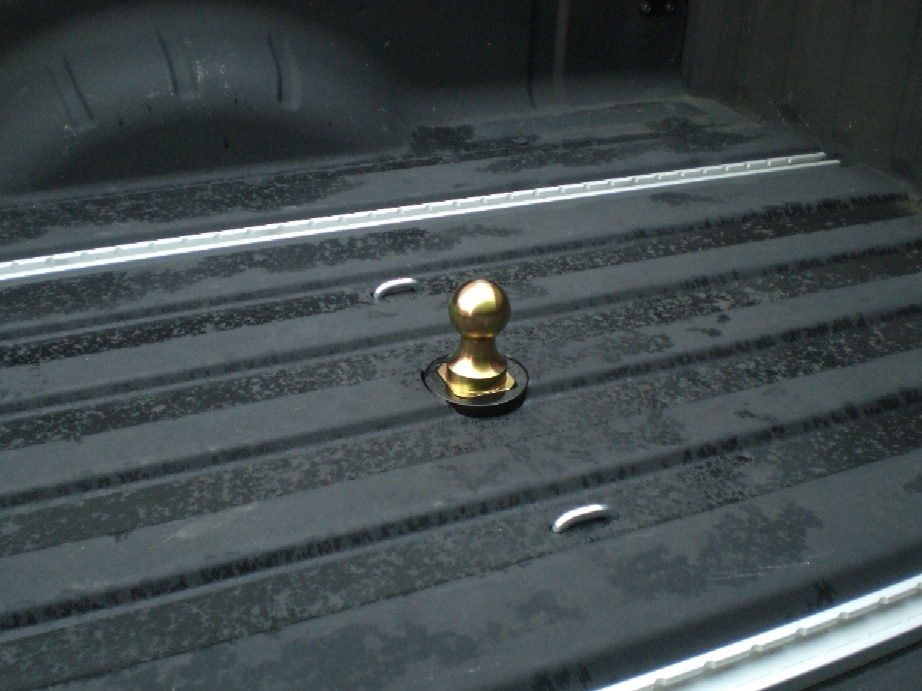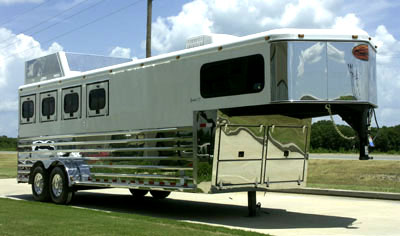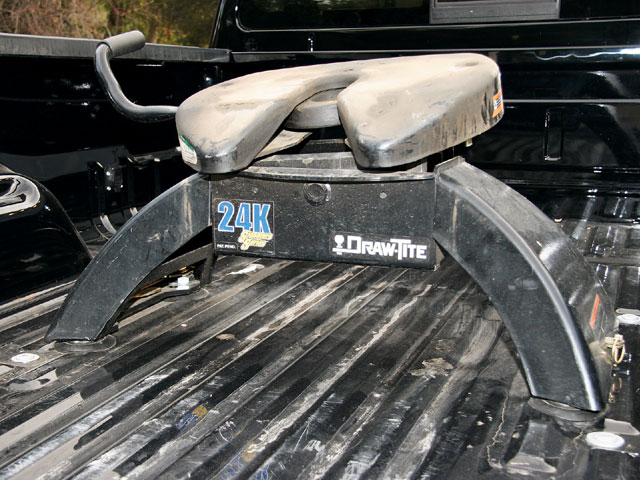A Tundra Owner’s Guide To Horse Trailers
Benjamin | Mar 16, 2011 | Comments 28
The Toyota Tundra offers an impressive towing capacity, with the 2011 model maxing out at 10,400 lbs with the optional tow package installed. While five tons of towing power might seem like more than anyone would ever need to use, there are a few applications that routinely touch – or even crest – this lofty weight figure. Of those, one of the most common can be found in the equestrian world, where horse trailers, the animals themselves and the gear that goes with them can add up to a hefty load to haul around.

A 2007 Tundra pulling a Lakota HUT (horse utility trailer), i.e. 2 horse with a changing room. Image from MrTrailer.com review - click to see the original review.
What follows is a description of the basic horse trailer options for 2007+ Tundra owners, including an interview with Sundowner, a horse trailer manufacturer.
Gooseneck Horse Trailers
For those who might need to haul only a single horse from time to time there are a number of small bumper pull trailers available on the market. For everyone else, the most popular option is to select a gooseneck-style trailer. Gooseneck trailers are named for their extended upper section that reaches into the bed of a pickup truck and connects to a special gooseneck hitch that mounts in the middle of the bed. These trailers are frequently much longer and heavier than bumper pull trailers – due to their ability to haul multiple horses and reams of cargo – and they exhibit a number of different towing characteristics when compared against other in-the-bed or bumper pull trailers.
Gooseneck Drawbacks
While gooseneck trailers offer impressive load stability and tons of interior room, there are a number of caveats that go along with their design that can be a turn-off to Tundra owners looking to use them to haul horses. The first is their weight – even the lightest of gooseneck trailers can strain the capabilities of the 5.7-liter Tundra when fully loaded.
The second has to do with the design of the hitch itself. A gooseneck hitch is installed towards the middle of the pickup truck bed, which can place the front of the trailer dangerously close to the cab of short box Tundra models. This adds extra anxiety while negotiating sharp corners or reversing a trailer. The hitch also requires drilling through the truck bed and connecting the hitch much farther ahead than where the Tundra was originally designed to bear a tow load. While this is not a problem on three-quarter and full-ton trucks where frame designs can handle this type of displaced load, on a half-ton truck there can be concerns regarding the security of the hitch mounting point and the stress it places on the frame – particularly for very heavy gooseneck trailers.
Expert Advice from Sundowner Trailers
To get a better idea of whether a gooseneck horse trailer was the best option for Toyota Tundra drivers, and to find out more about how these trailers stack up against the alternatives, I spoke with Tim at Sundowner Trailers. Sundowner is one of the premier horse trailer manufacturers in the United States, and the company sells both gooseneck and traditional bumper pull units.
One of the first questions that I asked Tim was whether Tundra owners might be better off using a fifth wheel-style hitch in place of a gooseneck trailer for hauling horses and other livestock. A fifth-wheel hitch offers more weight carrying capacity than a gooseneck without the worry of impacting the cab of the truck with the long overhang of the gooseneck. Tim explained that there are a number of factors that drive livestock haulers away from fifth wheel setups and into gooseneck trailers.
Fifth Wheel Sacrifices
Unlike a gooseneck hitch – which is relatively compact and which can even be turned over in some cases to make the hardware completely flush with the truck bed – a fifth wheel hitch takes up a lot of space in the cargo area. This big rig-style hitch can wipe out the practicality of a pickup truck fairly quickly and require the installation of a forward-mounted toolbox in order to recover some of the utility of the now crowded truck bed. Another problem with a fifth wheel trailer is that the truck’s tailgate needs to be removed in order to use it, which is not an issue with gooseneck installations.
Goosenecks also have a little more connection flexibility off-road, where horse trailers often go. 5th wheel hitches are designed for car haulers, RVs, etc., and they’re not likely to be hitched or manuevered on a horse-trail access road. While most new fifth wheel hitches have the ability to accommodate some “tilting” of the bed, they simply don’t have the off-road range that a gooseneck trailer hitch has. This is one of the main reasons horse trailers continue to use a gooseneck setup while nearly every other larger trailer utilizes a 5th wheel hitch.
Loaded Trailer Weights
I also asked Tim if there was a good rule of thumb for horse trailer users to employ when estimating the weight of their horses and tack. Tim explained that most horse owners are familiar with the weights of their individual animals, but that when designing its trailers Sundowner uses a figure of 1,200 lbs per animal to represent the average horse. This is something that gooseneck trailer buyers can keep in mind when looking at the listed capabilities of Sundowner’s trailer offerings.
Half-Ton Advice
I wrapped things up with Tim by asking him his advice for half-ton truck owners, like those driving a Tundra, who are interested in a gooseneck setup. He said that the most important factor to keep in mind when selecting a gooseneck trailer was the need to stay within the listed weight limits for the truck in question. Tim explained that for Sundowner products, this would mean sticking to a two or three horse trailer on the outside. He also explained that for those concerned about the front of the trailer impacting the rear of the truck’s cab, it is possible to install an offset gooseneck hitch that will give between four and six inches of additional breathing room.
Gooseneck Verdict
Gooseneck horse trailers, which offer a maximum capacity of close to 30,000 lbs, are still essentially the province of three-quarter and full-ton trucks. However, if carefully selected in order to respect the Tundra’s maximum towing capacity when fully loaded with horses and gear, a gooseneck trailer can offer a serious upgrade in stability and security when compared to bumper pull units.
Horse Trailer Advice for Tundra Owners
1. Don’t trust the trailer salesperson when it comes to figuring out what your truck can and can’t haul. Ask the trailer dealer for weight specs on the trailer (you need total dry weight as well as estimated tongue weight), and then bust out your calculator and start figuring out if your truck can manage the trailer safely. This post on Tundra towing basics (and the comments below the main article) contains a lot of advice on figuring this stuff out. Sundowner uses an estimate of 1,200 lbs for the average equine, so that’s probably a safe figure for most Tundra owners doing the math at home.
2. Don’t rely upon the Tundra’s max trailer weight rating to determine horse trailer compatibility. Many Tundras are rated to pull 10k lbs, but that doesn’t mean you can necessarily buy a 10k lbs horse trailer. The tongue weight of the trailer must also be less than the Tundra’s max payload rating (1600 lbs, give or take). A typical 2 horse trailer will weight less than 8k lbs fully loaded, but if the trailer requires the use of a gooseneck hitch, it’s probably at the Tundra’s maximum safe rating. Since a gooseneck trailer has a 20-25% tongue weight, an 8k lbs trailer is at or slightly over the rated payload max.
3. Good horse trailer rules of thumb for Tundra owners:
- A 2 horse trailer with a “changing room” or “utility room” is just about the max a Tundra owner can expect to pull safely, based on an informal survey of trailer manufacturers at this year’s National Western Stock Show. You may be able to find a very light-weight 3 horse, but that could be a long-shot.
- It’s harder to pull a gooseneck horse trailer with a CrewMax – at least not without an offset hitch. The 5.5′ bed is just a little too short. If you can get a double-cab with a long bed, you’ll be rolling with a large margin of safety, but a 6.5′ bed should work just fine with most horse trailers.
- Bumper pull horse trailers are probably the best choice for CrewMax Tundra owners, just be sure to verify the weight rating
4. When it comes to pulling more than 2 or 3 horses, you need an HD truck. There’s no substitute for a really big truck if you need to pull a really big trailer, and because so many horse trailers use a gooseneck hitch, the high tongue weights necessitate a 3/4 or 1 ton. The biggest trucks you see on the road – big one-ton duallys – are often used to pull very large horse trailers. If you imagine the weight of 4-6 horses, plus gear, plus the trailer weight, and then you imagine 20-25% of it must be carried as payload because of the way a gooseneck works, you understand why a big giant dually truck is needed.
Filed Under: TundraHeadquarters.com





We tow a 23′ travel trailer with our ’09 CM, and it does quite well, as it is a smaller trailer. But one of the big criticisms that is often leveled against Tundras is the payload rating. It is way out of balance with the 10K+ tow capacity. The rule of thumb for trailers is 10% of the trailer weight will be on the tongue, and even more for 5th wheels. A 10K lb trailer will have 1000 or more pounds on the tongue, and that eats into that anemic 1500 or so pounds of payload pretty quickly. Doesn’t leave much headroom for people, and any stuff you might put in the bed.
[…] 2007 Tundra Crew Max and Horse Trailer A Tundra Owner’s Guide To Horse Trailers | Tundra Headquarters __________________ 2011 4×4 TRD 5.7, Barcelona Red, Dbl Cab, TOW […]
BobG – Great point. I’ve heard some people say that tongue weights can be as high as 25% depending on the design of the trailer. Horse trailers usually use a gooseneck hitch, which has an even higher tongue weight than a 5th wheel…which is why the article talks about going with a 2 horse + changing room trailer at the very maximum. Anything bigger exceeds the Tundra’s payload rating.
Thanks for commenting!
We just bought a 4 horse gooseneck sundowner which weighs less than 5K. All Aluminum , so this 4 horse should be fine for my 2008 5.7 L Tundra with the towing package right?? Planning on only drawing 3 horses with it all less than 1100 each…
ryan – See point #2 in the “horse trailer advice” section. It’s the tongue weight you need to be concerned about. Do you know what the tongue weight is for your trailer as a percentage of full load?
Well that is a great ? that no one seems to be able to tell me. SO guess I will have to go to a scale and find out. The sundowner trailer rep says the trailer weight at 8000# will have a tounge around 1000#. I called toyota and they said the truck would ‘absolutly’ have no trouble in pulling this weight and not to worry about the 25% tounge weight ratio as this is only an extreme case scenario and that my size trailer will not go over the payload!! I am not satisfied with these answers b/c none of them seem very objective. So I guess I will actually take the trailer to a scale, but I have no idea where to find one??? Thank you for your feedback……
Ryan – I think a 1,000 lbs tongue weight is very, very low for a horse trailer. The gooseneck hitch raises the tongue weights quite a bit, and the trailer manufacturer we interviewed agreed.
However, I’m curious to see what the scales say too. Good luck – love to hear how it turns out.
Okay I just had the new trailer inspected for the state of vermont and asked the RV trailer business to weigh trailer and tounge weight. I was pleasantly surprised. The trailer weighs 4800# as it should have been and the tounge weight is 903# at the hitch…..this is 4 horse sundowner gooseneck. So I am fairly confident now that carrying 2 horses and tack my Tundra should be okay, but I will be sure to reply back any problems I run into so we all can learn from this!!!!!! Thanks for your comments.
Ryan – I think it’s close. If you figure that tongue weight is 19% of the total weight of the trailer, and if you figure four horses and tack weighs 4500 lbs, you’re at 1,767. That’s over the payload rating of the truck before you subtract the weight of the drivers, passengers, gear in the truck, etc.
I’m not saying that I wouldn’t do it (I’ve never let a couple hundreds pounds of extra payload stop me before), just saying that technically you’re over. This is why three horse trailers are the suggested limit. 🙂
Good luck – love to hear how it goes and thanks very much for commenting. Have fun!
Yes with 4 I feel uncomfortable. I plan on only 2 horses and tack which is what we planned on all along…..then in 3 years trade in the tundra for and F250 or Chevy 2500…..unless of course Toyota can come up with something that would match either of those. Really wish they would as I love the tundra!!!!
I am glad I found this thread this morning. I own 2007 Tundra DC 5.7L…and ALMOST sold my Sundowner 2H bumper pull trailer today to buy a small 2H gooseneck with some LQ in the front. After recalculating the payload (which I agree is low)…I decided that I would be at or exceed max payload with the Tundra: 2 horses, tack, hay, LQ and people. It wasn’t the total weight for towing — it was the PAYLOAD calculation and using 25% of loaded trailer. It would have worked if the GN didn’t have LQ finish. And it’s the LQ is why I wanted to move up to a new GN. The good news, is that my 2H BP, is pulled very well with the Tundra using a weight distributing hitch. I truly enjoy the Tundra for it’s design, power and quiet ride…as well as my 2H BP trailer — which will have to work for now as I am not giving up the truck.
Lynne – Glad we could help!
Good, I am glad you found it. No doubt the LQ must seriously increase your front end weight, too bad you can’t put the trailer on a tounge wieght scale, as I was very surprised how LITTLE tongue weight was in my 4 horse GN. It may be worth asking, perhaps the manufacturer took that into consideration when building the LQ……….good luck
Hi,
I am really glad I found this stream. I have been wondering about what type of horse trailer to buy. I have a 2010 Tundra 5.7L with towing package. I really want a 2 horse gooseneck trailer because of the versatility of the dressing room, but I am worried about overloading the truck. I would like to haul 2 horses no more than say 1200#. Help and advice please.
I am no expert in the field, but based on my experience you will have no problem with a two horse loaded with tack in trailer or truck……………enjoy……still have the dealer of the trailer check the tongue weight of the trailer and that will answer a lot your questions about payload concerns.
Staci – 2 horse + changing room is A-OK. Every trailer manufacturer we talked to said as much, and the math I did to verify what they were saying always worked out. 3 horse is borderline. 4 horses? Forget about it.
Hi,
I too have a 2010 Tundra DC 5.7L 4×4 with a towing package, and I am trying to decide between two different horse trailers to purchase. My preferred trailer is a name brand, 2003, aluminum 2 horse with a dressing room. Jason, you mentioned above you have done the ‘math’ to verify that this type of trailer will be A-OK for the truck to haul. Will you please, step by step, show us less experienced trailer people how to do the math? The trailer weights 4000lbs, two horses at 1200lbs each, 4 passengers, and tack and equipment (approximately 300lbs). The trailer dealer assures my truck can handle the load with a large margin of safety, but I really want and need to be sure. We are talking about the safety of my children and pets.
The above mentioned trailer is a gooseneck!
Mandy – See the “Horse Trailer Advice for Tundra Owners” section of the post. The math is explained there, as well as in some previous comments.
I am in the sam boat as many others here.
I have a 3 horse goose neck with tack room. It weighs 4400 empty. Two horses is all we ever put in it that weight about 2700 combined plus around 300 in tack, hay, etc. So the total is about 7400 lbs. At 25% the tounge weight will be 1850 so im over already and havent even factored in myself and a passenger on the payload. Really would like to get a tundra, but looks like a 3/4 ton may be the way I have to go.
Also, from a legal standpoint, correct me if im wrong, but i have heard that if your truck is overloaded (in this case over on payload) lawyers can have a field day if you had an accident with it.
please share your thoughts.
Mark – Your math seems correct to me – a 3 horse gooseneck trailer is a bit too big for a Tundra (and probably too big for all half-tons except for F150s with a special “work truck” payload package).
As for the legality, I’ve been told exactly what you’ve been told for years, from a variety of people. As I understand it, the core legal concept is that civil liability changes when someone can prove negligence. If a person is hauling more weight than their truck can handle, that’s the definition of negligence, and that means it’s a lawsuit waiting to happen.
LMAO at some of these comments and this write up. I’ve been pulling trailers for a long time. I am here to tell you that truck can handle a gooseneck in a 2 or 3 horse with zero problems. Heck. I used to use my 4.7 ltr 2002 tundra to pull a 2 horse gooseneck horse trailer. Never have I ever had a single issue with pulling. I just sold my 4700lb 2 horse gooseneck for a 3 horse 4500lb gooseneck all aluminum. I put bags on my Tundra to help support the weight of the tongue of the trailer. Plenty of power, no sway or issues at all. I have had that truck loaded to the max and it still had power and stability a plenty.
If your going to pull bigger than a 3 horse, ya, go with a bigger truck, but a 3 horse goosneck is not pushing this truck especially an aluminum one. If you cant pull a gooseneck with this half ton truck, wtf are they doing making a truck with all that power and tow capacity???!!!
Toyota proclaims it to be a towing machine with big over sized front breaks. so why now are Tundra owners being told not to pull? Why even buy the 5.7ltr? go get the 4.7 and save yourself the fuel then.
Hey Dan does your trailer have any kind of LQ or changing room? We are looking into getting a bigger trailer with LQ but don’t know of anyone who pulls one with a 5.7 L Tundra. But I have seen stock trailers and trailers of similar builds pulled with them.
Dan, I have the 2011 tundra 4.6 and am in the process of buying a horse trailer-probably bp 16 aluminum(I like having my camper shell)-3-4 horses. Anyway , I think back to the 80’s when I was a new driver(3/4 ton truck)-towing heavier horse trailers. My small v8 tundra is a much stronger truck(has tow package)-way more power(also more importrant ,much better brakes and stopping) than that 80s era truck had. The newer trailers also have better brakes. So yes there is always bigger and better. I read the forums and think maybe my truck wont do it well, but then I think back to what I had previously and experience tells me yes it will work fine, and will be safe.
Very interesting discussion. We carriage drive with a 20′ Exciss 4 horse aluminum stock trailer. Weight 4,000#, hitch weight empty 1000#. Payload is the issue with the Tundra not towing capacity. I built a device to measure hitch weight (lever, fulcrum and a bathroom scale (see: Archimedes ca. 1000 BC)) and measured the effect of loading on hitch weight. The key to keeping hitch weight manageable is to pay attention to where the load is in relation to the axles. Light items go in the gooseneck, Our carriage, hay, and heavier supplies go in the front half as close as possible to the center gate which is just in front of the axles. About 20% of their weight is reflected in increased hitch weight. The two horses go in the back facing forward and since they are over and behind the axles they reduce the hitch weight by about 400#. By careful loading we have managed to keep the hitch weight to about 1400# which when you add in driver, passenger, and dog just about reaches the payload limit of the Tundra without going over.
Rick,
Wow that is impressive stuff! I have to say that is one of the most well thought out “how to tow” explanations I have read.
-Tim
[…] I bought (but am impatiently waiting to receive). You could do with a gooseneck trailer. Here is a good blog post about horse trailers. You should be able to get the idea of what the Tundra can safely pull. […]
I have a 2007 Crew Max with the towing package (10,000 lbs). I have a bumper pull that weighs 3,652#. I am trying to figure out if I can add a cab-over camper that weighs 1,345# (all empty). I will need a hitch extension as well. Anyone know?